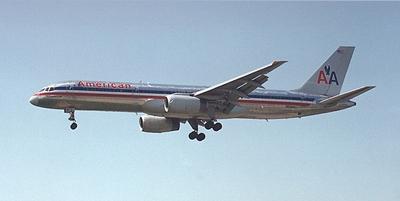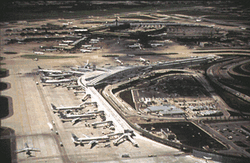NTSB Prelim Notes AA Crew's Decision To Continue On Battery
Power
What seemed initially to be a relatively minor runway overrun
incident at Chicago's O'Hare International Airport last month has
become something much more interesting... with the revelation the
American Airlines Boeing 757 landed with limited electrical
power.

And, according to the National Transportation Safety Board's
preliminary report on the September 22 incident, it did not have to
be that way. The Board notes the plane's flight crew opted to
continue on their journey even after they lost electrical power,
and had to switch to backup reserves.
American flight 268 departed Seattle-Tacoma International at
0802 PDT September 22, bound for New York's JFK International.
While en route, the crew received cockpit warnings of a failure of
the standby power bus, and trouble with the engine indicating and
crew alert system (EICAS). After consulting a quick-reference
handbook, the crew switched the standby power selector to the BAT
position -- meaning the airliner's electrical system was now
operating largely on battery power, which according to the QRH
would provide bus power "for approximately 30 minutes."
 According to the NTSB
prelim, the crew of Flight 268 then consulted with the airline's
maintenance department... and elected to continue the flight on
battery power, with several items shut down to conserve
electricity.
According to the NTSB
prelim, the crew of Flight 268 then consulted with the airline's
maintenance department... and elected to continue the flight on
battery power, with several items shut down to conserve
electricity.
Battery power began to dwindle as the plane overflew western
Michigan, around one hour and 40 minutes later. "...Several cockpit
electrical systems began to fail. The airplane was over western
Michigan and the captain elected to turn around and divert to ORD,"
the prelim states. "Also, the flight attendants discovered that
public address (PA) and the cabin/cockpit interphone systems were
inoperative. A flight attendant wrote a note and slipped it under
the cockpit door to inform the flight crew of their communication
problems.
"A short time later, the cabin crew was informed that they were
diverting to ORD. One of the flight attendants then walked through
the aisle informing the passengers of the unscheduled landing at
Chicago."
Given the circumstances, the approach to O'Hare appears to have
been fairly uneventful... but the flight crew declared an emergency
as a precaution, which would soon prove to be a prescient move.
From the prelim:
"As the airplane neared the runway on
final approach, the flightcrew discovered that the elevator and
standby elevator trim systems were inoperative. The captain then
assisted the first officer on the flight controls and the approach
to land was continued. The systems required to slow the airplane on
the runway appeared to indicate normal, and with the elevator
control issues the flightcrew did not want to perform a go-around
to land on a longer runway. Pitch control of the airplane was
difficult so the flightcrew elected to stop the flap extension at
20 degrees. The touchdown was smooth despite the control issues,
however, the thrust reversers and spoilers did not deploy. The
captain attempted to manually deploy the thrust reversers, but
still was not sure if they deployed. The captain was concerned
about the brake functionality and accumulator pressure so he made
one smooth application of the brakes, which did not "perform well."
Due to obstructions off the end of the runway, the captain elected
to veer the airplane off the left side of the runway into the
grass."
None of the 192 passengers and crew onboard the airliner were
injured. As a side note, neither of the aircraft's twin turbofans
responded to regular shut down procedures by the flight crew...
forcing the crew to depress the fire handles to command engine
shutdown, while also flooding both with Halon.
The NTSB's subsequent investigation showed the 757 touched down
approximately 2,500 feet down the runway, with witnesses reporting
"loud pops" as the left maingear hit the runway, with touchdown of
the right mains 165 feet further down. "These skid marks were
visible for the entire length of the runway up until the airplane
departed the pavement," the NTSB adds.
 The Board also determined the cause of the power failure:
The Board also determined the cause of the power failure:
"Post incident investigation revealed
a failure of the B1/B2 contacts in the K106 electrical relay. With
the standby power selector in the AUTO position, this failure would
have resulted in a loss of power to the battery bus and the DC
standby bus, which would have resulted in the AIR/GND SYS message
and illumination of the standby power bus OFF light which the
flight crew received.
"With the standby power selector in
the BAT position, as selected by the flight crew, the main battery
provided power to the hot battery bus, the battery bus, the AC
standby bus, and the DC standby bus. In addition, the main battery
charger was not receiving power, and thus the battery was not being
recharged. When main battery power was depleted, all 4 of the
aforementioned buses became unpowered."
The NTSB's final report on the incident is still many months
off... but the prelim contains enough evidence to raise eyebrows in
several respects, in particular the crew's decision to continue
their flight even with a serious electrical issue.
"They should have landed as soon as practical," Michael Barr, an
instructor at the University of Southern California's Aviation
Safety and Security Program, told USA Today. "That would have been
the conservative approach. I don't see why they thought they could
fly all the way across country on their backup electrical
system."
The newspaper adds that so far, no one at American Airlines or
its pilots union, the Allied Pilots Association, has opted to
comment on the incident, or the NTSB's report.
 ANN's Daily Aero-Linx (04.15.24)
ANN's Daily Aero-Linx (04.15.24) Classic Aero-TV: 'No Other Options' -- The Israeli Air Force's Danny Shapira
Classic Aero-TV: 'No Other Options' -- The Israeli Air Force's Danny Shapira Aero-News: Quote of the Day (04.15.24)
Aero-News: Quote of the Day (04.15.24) Airborne 04.16.24: RV Update, Affordable Flying Expo, Diamond Lil
Airborne 04.16.24: RV Update, Affordable Flying Expo, Diamond Lil ANN's Daily Aero-Term (04.16.24): Chart Supplement US
ANN's Daily Aero-Term (04.16.24): Chart Supplement US





